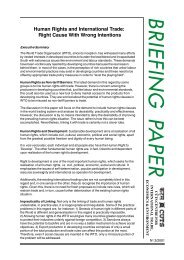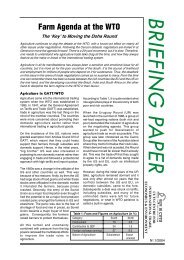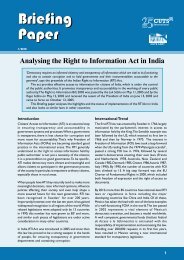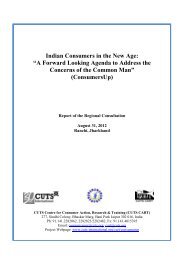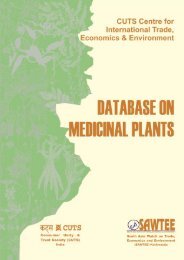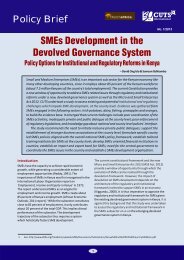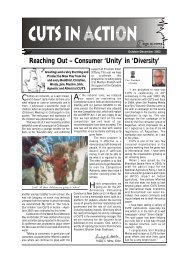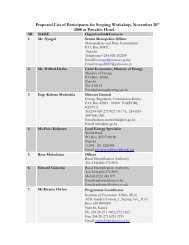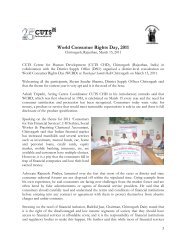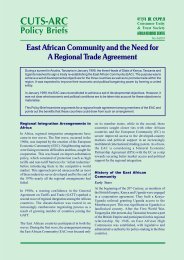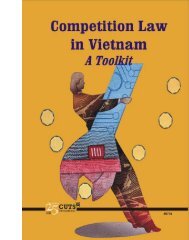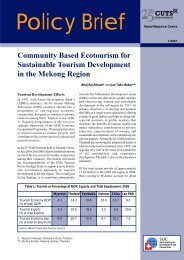Final Report - World Trade Organization
Final Report - World Trade Organization
Final Report - World Trade Organization
You also want an ePaper? Increase the reach of your titles
YUMPU automatically turns print PDFs into web optimized ePapers that Google loves.
Whereas some authorities handled some of the cases<br />
very seriously (regardless of whether they were<br />
successful at the end), others have not acted at all or<br />
only with limited interest or in just few of the cases.<br />
Although several problems are caused by the special<br />
nature of such cases, sometimes the authorities’ own<br />
lack of action or interest is also an important factor<br />
to take into account. This is of course due to a variety<br />
of circumstances, but nevertheless gives some<br />
valuable insight. We will also discuss some issues<br />
that have not been dealt with by the competition<br />
authorities but have an important bearing on<br />
developing countries.<br />
7.1 Sources and Types of Cases<br />
The types of anti-competitive practices with<br />
international dimensions are similar as they are for<br />
purely domestic cases. The difference only lies in<br />
the cross-border (international) dimension of the anticompetitive<br />
behaviour. A number of areas where<br />
enterprise behaviour is perceived to give rise to<br />
competition concerns with international dimensions<br />
are discussed here. These issues can broadly be<br />
classified into four groups:<br />
l<br />
l<br />
l<br />
l<br />
Exercising market power in global or export<br />
markets.<br />
The anti-competitive practices that fall under this<br />
category are international cartels, export cartels<br />
and related arrangements, international merger<br />
or merger with international spill-over, abuses of<br />
dominance in overseas markets, cross-border<br />
predatory pricing and price discrimination.<br />
Barriers to import competition.<br />
Import cartels, vertical market restraints creating<br />
import barriers, private standard setting activities,<br />
abuse of monopsonistic dominance etc. may fall<br />
under this category.<br />
Foreign direct investment.<br />
Intellectual property rights.<br />
7.2 Exercising Market Power in Global or<br />
Export Markets<br />
7.2.1 International cartels<br />
There is a long history of price fixing cartels in which<br />
multinational companies carve up the world into areas<br />
of control. Recently there has been a sharp increase<br />
in global cartel activity. Simultaneously, enforcement<br />
agencies have slapped multi-million dollar fines against<br />
vitamin companies, food additive makers, steel<br />
manufacturers etc. To date only a handful of countries<br />
have taken action to penalise transgressing companies<br />
or to recover compensation. No developing country,<br />
except Brazil, has taken any action on these cartels.<br />
A <strong>World</strong> Bank study has shown that in 1997,<br />
developing countries imported $81.1bn of goods from<br />
industries in which price-fixing conspiracies have<br />
been discovered during the 1990s. These imports<br />
represented 6.7 percent of imports and 1.2 percent<br />
of GDP in developing countries. There might have<br />
been several other price-fixing conspiracies, which<br />
remained undiscovered. Moreover, all these cartels<br />
are made up of producers, who are mostly from<br />
industrialised OECD countries.<br />
The vitamins cartel alone has cost the developing<br />
countries about $3bn in the 1990s. The additional cost<br />
that India had to incur due to this cartel is estimated<br />
to be $25mn in 1990s. These are absolute figures. If<br />
analysed on a PPP (purchasing power basis) the<br />
impact is five times as high for India, or $125mn.<br />
Some other important international cartels that hit<br />
the developing countries very hard are those in heavy<br />
electrical equipments, steel and aluminium. The first<br />
two of them were never prosecuted, but their<br />
existence and their agreements were exposed by the<br />
US House of Representatives and at the OECD.<br />
Neither of the first two operated in the US but the<br />
products concerned were very important for<br />
developing countries. The aluminium cartel was set<br />
up with the active support of the US and the EU<br />
governments and it operated worldwide. Steel being<br />
one of the basic goods for different industries, most<br />
developing countries, without indigenous capacity,<br />
had to suffer because of high prices.<br />
Heavy electrical equipment is another item that<br />
almost all developing countries require, to install<br />
electricity generation plants to meet their growing<br />
energy demand. But higher prices of heavy electrical<br />
equipments due to cartelisation have significantly<br />
raised the cost of installing electricity generating<br />
plants and thereby making energy more expensive.<br />
Available records suggest that among the 7-Up<br />
countries, India, Pakistan, South Africa and Zambia<br />
were victims of bid rigging by the heavy electrical<br />
equipment cartel members.<br />
The cartel members used their excess profits to<br />
engage in predatory pricing against newcomers,<br />
particularly from developing countries. For example,<br />
predatory pricing drove the independent local<br />
manufacturers in Brazil to bankruptcy. However, on<br />
74 w Pulling Up Our Socks



